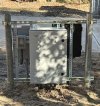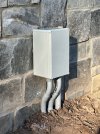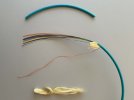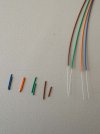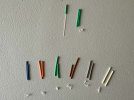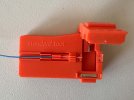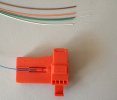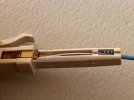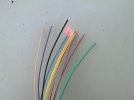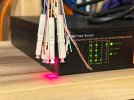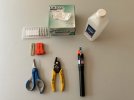D. Execution details – deep dive
Existing conditions were that I have two ¾” conduits buried in the ground, around 330 feet long including verticals at each end, from the wall of the house to the far end. From the wall, approximately 70 feet through the crawl and up to the wiring center.
Line power live at far end in a separate 1” conduit.
I now better appreciate that for a long run,
1½” conduit is preferable, two runs if possible. The set up of trenching and restoring is a pain, and future-proofing with two 1 ½” runs is a good move if one can do it. Even 1” conduit would be much better than ¾”.
However, I had two ¾” runs in the ground, and making this work would be great.
At the far end I ended up rebuilding the controls panel replacing existing 4x4 pressure treated posts and frame with 2 ½” galvanized steel posts in concrete, two horizontal C-channels, channel clamps, and DIN rails. All these are available at Home Depot, see links in next post. All this worked out fine.
I bought a large
weathertight outdoor enclosure for all the low voltage equipment. I bought it directly from the manufacturer, and it is also available through Home Depot. This enclosure worked out well.
Use a hole saw or step drill bit to make holes in boxes for cables, clamp/secure the box else the hole maker can catch, which can produce unexpected/undesired results and tear up the hole.
At the house end of the cable in buried conduit, I cut out the 4x4x2 existing box, and replaced it with a larger generic weathertight box. The box worked out fine and gave me vertical clearance when it came time to pull the cable.
I had smurf conduit at hand and used it to for the horizontal run in the crawl space, from the wall penetration to the bottom of the vertical conduit going up to the writing center.
I had Klein
pull string in the ¾” conduits and used it to pull
½” pulling tape as an intermediate step. By the way, the simplest way to pull string into a conduit is to tie a section of plastic sheet from a grocery store bag, and suck it with a shop vac. It works surprisingly well.
So far, everything is regardless of what kind of cable you are going to pull.
I used Klein
foam lubricant in the conduit. It expands and is not messy. It does expand in all directions so be prepared to stuff a rag at the open end to keep it from flowing back out. I squirted into he conduit every 40-50 feet of cable. It comes with a long flexible tube. When I fed it into the conduit at either end, it would snag probable at the inside joint at 90-degree sweep elbows at either end. So I tried rotating it like a cork screw hoping that would get it past the snag points on the inside of the conduit. Unfortunately this ended up weakening and cracking the little plastic protrusion on the can on which the plastic tube goes, and the foam mostly oozed out of that crack. Ended up discarding the can. But if done thoughtfully it would help the pulling operation. Next time I would
follow the suggestion in this thread by @MTL4 and blow the foam lubricant with compressed air.
Now we get to the optical fiber part.
I used a 12-fiber plenum cable that a member posted a link to on ebay. I realize this is not burial grade and am hoping for the best. Will replace should that become necessary in the future, due to wet soil on my site.
Pulling any cable in a 330-foot ¾” conduit with 90-degree sweep elbows at either end is going to be hard. FO cable is light, so it was probably less hard than coax or copper ethernet would have been.
With FO, the question is how do you secure the pulling line to the FO, without destroying the FO cable in the pull?
Turns out to be surprisingly simple.
I
braided the Kevlar fibers into a string, looped the pull tape and the Kevlar, and knotted them. It worked fine. Use cable lubricant, see links, and above para.
Definitely need
two people for a cable pulling operation, one to feed the cable and one to pull. For that distance, the pull took some force. As you pull up, the tape bites into the plastic edge of the vertical conduit/fitting because while pulling you are likely be an angle. An "Insulating Plastic Conduit Bushing" would be useful to put at either end, but I had not anticipated this and just kept going.
Let’s say you got the cable through and have a nice working length at both ends.
The
next step is termination. Much of the input I got was that one should use pre-terminated cable. In ¾” conduit that is not an option.
One lone voice in this forum encouraged me to do it myself based on that member’s recent successful experience, with very helpful
links provided for tools and fittings. I got the tools, and added Kevlar scissors which probably I could have improvised around, but I like the right tools.
A note on termination. I believe there is a difference in
splicing FO, and
terminating FO. I agree that if one were splicing FO cable, training, the right expensive tools, and precision would be necessary. However,
terminating FO with basic mechanical connectors is within the reach of moderately hands-on people.
My first attempt at terminating FO was not great. The instructions that came with the tools and the parts are rather sketchy. I jammed the stripped and cleaned fiber into the connector and closed it. Accordingly, rather than a crisp laser dot through the cable you are supposed to get with the FO tester tool/flashlight, I got a hazy and scattered red glow. Then I remembered seeing a how-to video some time back where it was said to be sure to
open the sliding window on the connector before inserting the fiber. So I made a second practice termination on a short section of cable and on this second attempt I
got a nice round dot of laser beam with the tester. Links to tools and fittings in section above.
I set up a test bench replication of my long run. My third practice termination was with seven-foot strands that tested out fine, and I used them in place of the 400-foot run. This network assembly did not work. Then I thought that FO strands should cross-over so the transmit port at one end connects to the receive port at the pother, rather than the straight-through connection I had made based on my copper experience. Still did not work. Then I rebooted my router and switch. Within minutes everything was recognized on the network as hoped for, and that could only be possible if the FO connection was working. I realize now that inserting a transceiver in the switch is effectively adding a card.
When you buy pre terminated FO cables, they can only connect one way and probably take the crossover into account. However, when you are working with single strands, important to get the Tx and Rx connections right. There may not be markings on the transceivers, and a little common-sense comes in handy.
I found that when I used the stripping
tool casually and naturally, I got good results. In my first attempt I was trying to be careful and methodical. The results were not great. The tool designers did a good job and there is really no need to second guess tool holding angle and in which orientation to strip. When I held the tool naturally, and in the obvious direction, everything went smoothly.
At first it seemed tricky to measure out the precise required lengths of bare fiber, fiber with the white acrylate coating, and bare fiber. I then realized that on the fiber cleaving tool, even though there were no markings to that effect, or mention in the instructions, there are visual clues that suggest where to place the full fiber, stripped fiber, and bared/cleaned fiber that serve as confirmation of required length for each section. In my final process, I used a ruler and made marks on the cable with a fine soft felt tip pen.
I looked at the fiber under an inexpensive electronic microscope I bought 20-plus years ago at Radio Shack. The strand from the cable cut with cable snips was like a glass stube smashed with a hammer, and the ends were jagged. The strand from the inexpensive FO cleaver had a much cleaner and uniform cut end.
* Some might say use pre-terminated fiber cables, they are cheap, and fiber tools are expensive.
If you can get FO cables inexpensively, and pull them in the conduit you have without damaging and/or contaminating the cables, by all means do so.
I could not figure out a way to pull pre-terminated cables in 3/4" conduit that I had in the ground.
Tools were not expensive and I will always have them.
After practicing on two ends each of three FO strands, I went for it.
I have done a total of 14 FO terminations, and hundreds of copper ethernet cable terminations.
The level of difficulty of FO at this point is about the same as terminating an RJ-45 clip.
I'm an average person, did it, and think
most people here could terminate fiber.
Besides, its fun to do something new and better.
Most people are not here for Ring cameras.

